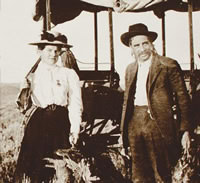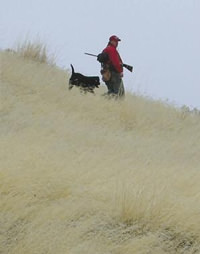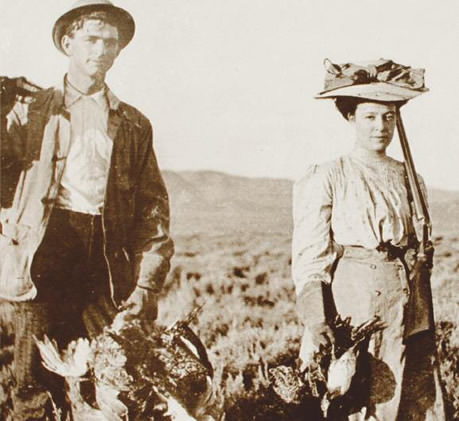FIELD AND STREAM
Water and upland bird hunters relish the season.
WRITTEN BY DORESA BANNING
PHOTOS BY ANDY McCORMICK
Like farm to table, in which farmers bring their fresh, homegrown vegetables and fruits directly to consumers, field to table is a way of obtaining fresh meat from the wild for people to eat. Bird hunting is a popular way outdoor enthusiasts do this in the Northern Nevada and Northern California region.
| Art and Ada Keddie (top) and Genevieve and George B. Williams (lower right) duck hunting in Lahontan Valley, circa 1910. Photo courtesy of Mert Domonoske |
 THRILL OF THE HUNT
THRILL OF THE HUNT
“[The game] tastes so much better because at the table you relive the memories of a day well spent in the field, which makes it more satisfying,” says Andy McCormick, hunter and vice-president of sales and marketing for Legacy Sports International, a Reno-based, global importer and exporter of hunting and shooting firearms.
Bird hunting falls into two categories: upland and waterfowl. Locally, hunters pursue waterfowl — Canada geese, various types of ducks, swans, and different snow goose species — in bodies of water such as the Truckee River, Stillwater Wildlife Refuge, and Humboldt Sink.
Upland birds hunted in the area include dove, partridge, pheasant, sage grouse, and (the most popular), chukar and Mountain and California Valley quail (perhaps because they offer tasty, lean, white meat). They’re found in open fields that provide cover, agricultural areas where they can forage, in mountains, and near water such as the Rye Patch Reservoir. Typically, hunters use 12- and 20-gauge shotguns to down avian game. Although rare, some hunters use a bow and arrow.
“Getting away from everyday life, being outdoors, enjoying wildlife, and the camaraderie you have with friends and family are awesome,” says Clay Belding, who stars with brothers Chad (the host) and Clint — all Renoites — in The Fowl Life, a television show on the Hunting Channel, which captures Team Maniac on waterfowl hunting trips and behind the scenes.
PREPARATION TECHNIQUES Because hunters enjoy sharing their bounty, you may find yourself gifted with a wild bird, unsure of what to do with it. Here’s some guidance:
Because hunters enjoy sharing their bounty, you may find yourself gifted with a wild bird, unsure of what to do with it. Here’s some guidance:
First clean it. This involves removing the head and feet, then plucking the feathers and leaving on the skin (which helps retain the juices) or skinning the bird (which is easier, quicker, and removes the feathers in the process). Then extract the guts, and either leave the bird whole or cut it into parts. Next, soak the meat overnight in salt water to draw out the blood. Then immerse the meat in milk, buttermilk, or cocoa butter overnight to eliminate some of the gamey taste. At this point freeze or cook it.
“The prep is really important,” McCormick says. “Make sure you clean them really well and keep them cold.”
Wild bird is great roasted, grilled, deep fried, barbecued, or rotisseried, but can be challenging to cook just right — medium rare or pink-red inside with dark meat and ever-so-slightly pink with white meat.
“It’s easy to overcook,” Belding says. “If it’s anywhere between medium and more done, it’s horrible, like shoe leather.”
Keep in mind that fruit such as apricots, apples, oranges, or raspberries along with mushrooms, shallots, and bacon all nicely complement wild bird. Brown sugar is a good match for duck.
Simple recipes include cutting the meat in chunks, cooking them in soy sauce, and eating them with rice, mashed potatoes, or polenta. One of Belding’s favorite duck recipes is breasts stuffed with Italian meat, cheese, and basil, and covered with olive oil and Montreal steak seasoning. Other favorites are swan and eggs, and pulled goose sandwiches with barbecue sauce, garlic, and peppers.
As for wine pairings, the more gamey the taste of the bird, the bolder the wine’s flavor should be, McCormick says. For example, Eagle Eye’s Infatuation — a red blend of Cabernet Sauvignon, Malbec, and Syrah — suits duck, dove, and grouse.
“If you’re going to get fancy, use the same wine to deglaze your frying pan,” he adds.
Whether or not you ever participate in the quest for a wild bird, seize the opportunity, when possible, to at least sample this “truly organic food,” as McCormick calls it. You may find that it flies off your table and flits with your palate.
Doresa Banning is a Reno-based freelance writer and editor who now has a much better idea of how to prepare wild bird.

WILD FOWL RECIPES
(courtesy of Kristy Crabtree of Nevada Foodies –– Nevadafoodies.com)
Canada Goose Pot Stickers
(makes 14 to 16 pot stickers)
INGREDIENTS:
2 goose breasts (marinate in teriyaki sauce for 2 to 3 days)
8-ounce can water chestnuts
8-ounce can bamboo shoots
4 green onions
1 large shallot
2 to 3 garlic cloves
Grated ginger
1/4 teaspoon cayenne pepper
Salt and pepper
DIRECTIONS:
Add all ingredients above to food processor. Process until fine stuffing is formed.
To form the dumplings, remove 1 wonton wrapper from the package, covering the others with a damp cloth. Brush 2 of the edges of the wrapper lightly with water. Place 1/2 rounded teaspoon of the goose mixture in the center of the wrapper. Fold over, seal edges, and shape as desired. Set on a sheet pan and cover with a damp cloth. Repeat procedure until all of the filling is gone.
Heat a 12-inch sauté pan over medium heat. Brush with vegetable oil once hot. Add 8 to 10 pot stickers at a time to the pan and cook for 2 minutes, without touching. Once the 2 minutes are up, gently add 1/3 cup chicken stock to the pan, turn the heat down to low, cover, and cook for another 2 minutes. Remove wontons to a heatproof platter and place in the warm oven. Clean the pan in between batches by pouring in water and allowing the pan to deglaze. Repeat until all the pot stickers are cooked.
Serve immediately with Pot Sticker Dipping Sauce
Pot Sticker Dipping Sauce
Mix together:
1 cup soy sauce
1 tablespoon red wine vinegar
1 tablespoon sugar
1 teaspoon chili sauce
1 teaspoon ginger (fresh)
1 clove garlic (chopped)


